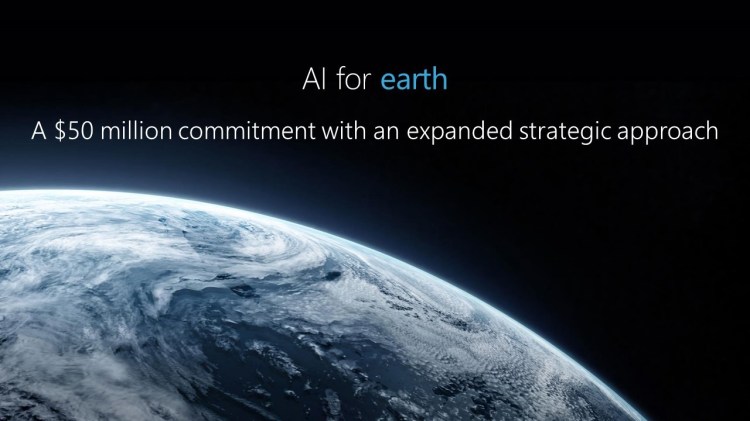Watch all the Transform 2020 sessions on-demand here.
Microsoft has announced an expansion to its AI for Earth program, committing an additional $50 million to organizations that are working to solve the climate change crisis.
The tech giant first announced AI for Earth back in June, and the initiative promised to provide a bunch of cloud-based tools and AI services to organizations looking to tackle problems relating to climate change. At the time, Microsoft said it was putting $2 million into the program, in addition to other add-ons, such as providing training on the use of AI. Today, the company announced an “expanded strategic plan” and a further $50 million over the next five years to “put artificial intelligence technology in the hands of individuals and organizations around the world who are working to protect our planet,” according to Microsoft president and chief legal officer, Brad Smith.
Paris agreement
The news comes on the eve of the two-year anniversary of the Paris Agreement, which was adopted by nearly 200 countries around the world in December, 2015. World leaders are reconvening in Paris tomorrow at the One Planet Summit to take stock and support the goals set out in the original agreement.
AI is already being used across many industries, from grocery picking / packing to online image searches, and tackling climate change should really be no different.
June 5th: The AI Audit in NYC
Join us next week in NYC to engage with top executive leaders, delving into strategies for auditing AI models to ensure fairness, optimal performance, and ethical compliance across diverse organizations. Secure your attendance for this exclusive invite-only event.
“At Microsoft, we believe artificial intelligence is a game changer,” said Smith. “Our approach as a company is focused on democratizing AI so its features and capabilities can be put to use by individuals and organizations around the world to improve real-world outcomes. There are few societal areas where AI can be more impactful than in helping address the urgent work needed to monitor, model, and manage the Earth’s natural systems.”
Managing and processing vast swathes of data is one key area where AI could help with climate change. For example, ground sensors or weather stations can capture myriad environmental data points, while AI can be trained to automatically classify the raw data that’s captured for human interpretation.
“Fundamentally, AI can accelerate our ability to observe environmental systems and how they are changing at a global scale, convert the data into useful information, and apply that information to take concrete steps to better manage our natural resources,” added Smith.
It’s worth noting here that Microsoft’s moves aren’t entirely altruistic. The company is keen to push its cloud and AI technologies into more environments, so to speak. Microsoft claimed that in the past six months it has awarded more than 35 grants globally for access to its Azure platform and AI technology as part of the AI for Earth program.
As for its “expanded strategic plan,” well, Microsoft said that it aims to grow its seed grants for creating and testing new AI applications across four key areas: climate, water, agriculture, and biodiversity. The company said it will provide more “advanced training” to universities and NGOs leveraging AI in their projects. Further down the line, Microsoft said that it will pick out the ones that show the most promise and make more substantial investments to help them scale. As part of this effort, the company is setting up a new “multi-disciplinary team” of AI and sustainability experts who will work with the latter-stage projects.
The company also hinted at its own plans for any technology that emerges from its investments, saying that it could be integrated into its own platform for use by others.
“As these projects advance, we’ll identify and pursue opportunities to incorporate new AI advances into platform-level services so that others can use them for their own sustainability initiatives,” said Smith. “Some of this will involve platform services that will be offered by others. In other instances, these may be incorporated into Microsoft’s own platform services.”


